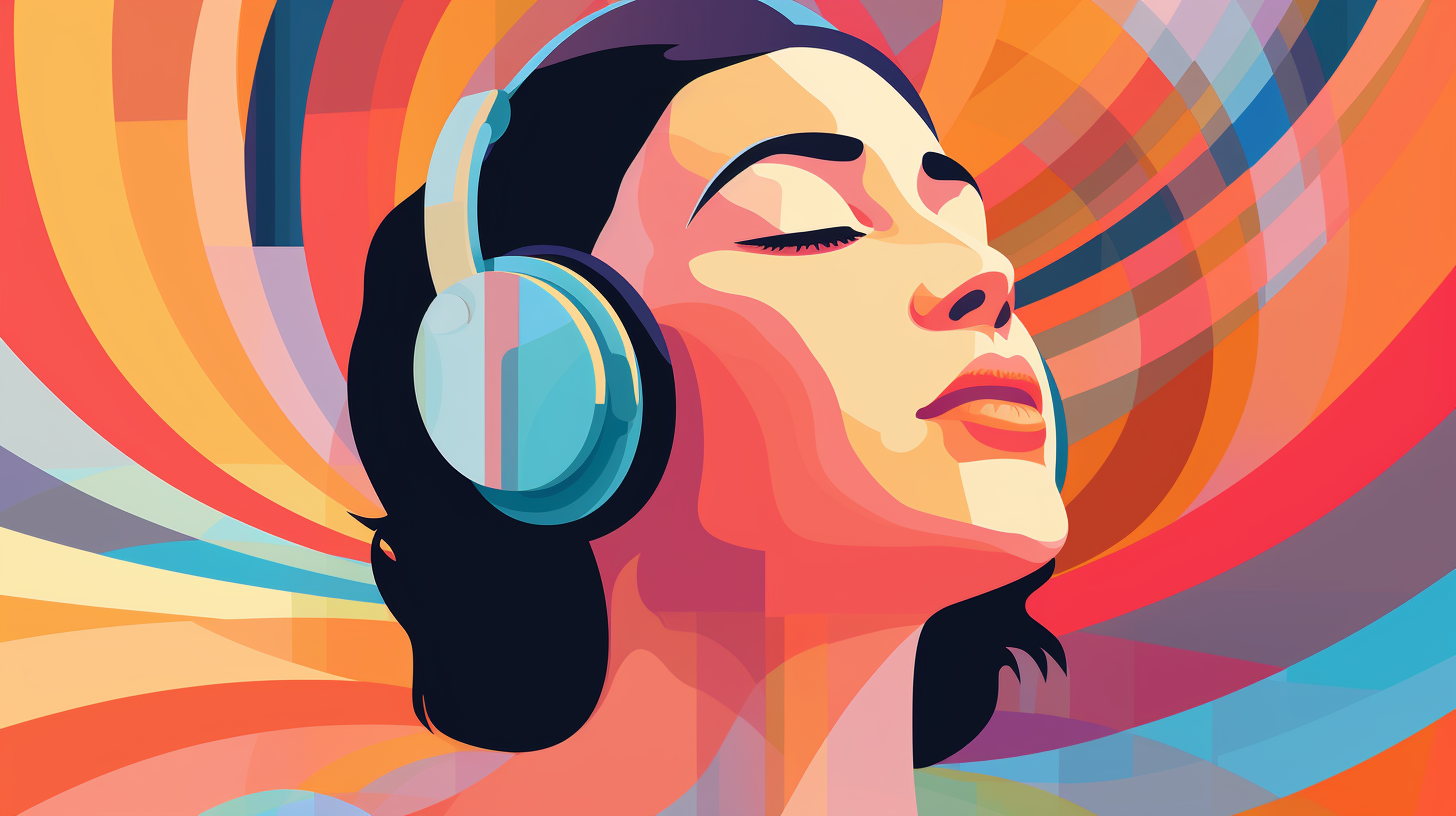What is NSDR? (The Science of Chill for Beginners)
Imagine a tool that lets your brain take a leisurely stroll, while your body gets a chance to pause and reset.


What is NSDR?
That's NSDR, or Non-Sleep Deep Rest, coined by neuroscientist Dr. Andrew Huberman. It's a unique state where your mind is awake yet profoundly relaxed, distinct from the phases of sleep or the active focus required in traditional meditation.
How do you do NSDR?
Practicing NSDR is straightforward. You listen to specially designed audio tracks that guide you through a relaxation process.
The NSDR tracks, usually 10 to 30 minutes long, employ a blend of verbal cues and sometimes soundscapes to engage your brain's relaxation response. This process involves activating certain neural pathways that signal your body to shift from a state of alertness to one of calm.

Benefits of NSDR
NSDR offers numerous benefits, which include:
🎯 Enhanced Focus and Clarity: By calming the mind, NSDR can help sharpen focus and reduce mental clutter (Kumar & Mallick, 2017); (Singh & Singh, 2010).
😌 Deep Relaxation: It provides a restful state that rejuvenates the mind, similar to the benefits of a good nap but without the grogginess (Chowdhary, 2013); (Chauhan, 2020).
💆♂️ Mood Regulation: Regular NSDR practice can improve emotional well-being, helping to manage stress and anxiety (Vaishnav et al., 2019); (Kumar & Mallick, 2017).
🛌 Sleep Quality Improvement: By training the brain to enter a state of deep relaxation, NSDR can indirectly contribute to better sleep patterns. (Datta et al., 2021); (Datta et al., 2022).
Yoga Nidra, also known as yogic sleep, is a more specific practice within this category and often includes a spiritual component. Both practices may involve body scans or guided meditation while lying down. This distinction is crucial when considering the applicability of Yoga Nidra studies to NSDR.
How to Practice NSDR
So, you're ready to dive into the world of NSDR?
To practice NSDR, find a comfortable, quiet space where you won’t be interrupted. Sit or lie down in a relaxed position, preferably with headphones on, and start the audio track.
Close your eyes and let the guidance take over. The key is to let go of expectations and allow yourself to drift into the relaxed state the audio guides you towards.

Here's where you can find those magical audio scripts that'll guide you to relaxation nirvana:
YouTube
Ah, the land of cat videos and, as it turns out, free NSDR tracks! Just search for "NSDR" on YouTube, and you'll find a variety of tracks.
Vespertone
Want variety? Don't want to get bored diving into the same track over and over?
Head over to Vespertone, where we've got a big library of NSDR tracks. Sign up here and you'll never run out of new ways to relax.

What are the best times to do NSDR?
Incorporating Non-Sleep Deep Rest into your daily routine can be a game-changer for mental health and clarity. NSDR is not just a one-size-fits-all solution; its versatility makes it ideal for various situations:
🌪️ During Anxiety or Overwhelm: A quick NSDR session can be a calming oasis, helping you regain composure and emotional balance.
🧩 Facing Mental Blocks: When stuck on a problem, NSDR offers a mental reset, clearing the way for new insights and solutions.
📱 Post-Digital Overload: Combat the fatigue of constant screen time with NSDR, providing a much-needed mental break and digital detox.
🌞 Morning Routine: Start your day with NSDR to establish a tone of tranquility and focus, making mornings more manageable.
🌙 Nighttime Wind-Down: Use NSDR to ease into a restful state, promoting better sleep, especially when your mind is active.
🌒 Awake in the Middle of the Night: If you find yourself awake and unable to fall back asleep, NSDR can help calm your mind and facilitate a return to sleep.
🔄 Anytime Reset: Like a quick mental breather, NSDR can be your go-to relaxation method throughout the day, whenever you need to recharge.
🛡️ Pre-Stressful Events: Before tackling challenging tasks, NSDR can help reduce anxiety and prepare your mind for what's ahead.

Erase the noise, seize the zen
Sign-up for a free 7 day trial — get access to all NSDR tracks.
😌I'm Ready to Relax & Recharge NowThe Science Behind NSDR
The magic of NSDR lies in its ability to downshift brain activity from the high-frequency beta waves (associated with alertness and stress) to the slower alpha and theta waves, states often linked to creativity, relaxation, and meditative states.
This shift is crucial for giving the brain a break from the constant stimulation of modern life.

Comparisons with Other Techniques
NSDR vs. Traditional Guided Meditation
Traditional guided meditation and NSDR are both effective relaxation techniques, but they engage the mind differently. In traditional guided meditation, the focus is on actively engaging the mind's attention, often through mindfulness or concentration on specific elements like breath or a mantra.
This process requires practice and discipline, as it involves training the mind to stay focused and return to the point of focus when it wanders. It's a cognitive exercise that strengthens neural pathways associated with attention, self-awareness, and emotional regulation.
NSDR, in contrast, is more about guiding the brain into a passive state of deep relaxation without the active focus required in meditation. It involves listening to specific audio cues that facilitate a shift into a restful state, allowing the brain to disengage from active thought processes. This makes NSDR particularly accessible for individuals who may find the active focus of meditation challenging or those who are new to relaxation practices.
NSDR vs. Hypnosis
Hypnosis and NSDR both use guided audio cues, but their objectives and methods differ significantly. Hypnosis is a therapeutic technique often used to induce a highly focused state of attention, combined with increased suggestibility.
It's typically used by trained professionals to address specific issues or behaviors, such as smoking cessation, anxiety, or pain management. The process of hypnosis involves leading the individual into a trance-like state where they are more open to suggestions and guidance for behavioral change.
NSDR, on the other hand, doesn’t aim to induce a state of heightened suggestibility or focus on specific behavioral changes. Instead, it's designed to guide the listener into a state of general relaxation and mental rest. NSDR tracks use calming narrations and soundscapes to promote a state of mental tranquility, without the directed focus on changing specific thought patterns or behaviors inherent in hypnosis.
NSDR vs. Napping
Napping and NSDR are both methods to rejuvenate the mind, but they function differently. Napping involves actually falling asleep for a short period, which can provide a boost in alertness and performance, especially if one is sleep-deprived. However, napping can also lead to sleep inertia, a state of grogginess and disorientation that can occur if one wakes up from deep sleep.
NSDR, in contrast, provides restorative benefits similar to napping but without the need to fall asleep. It guides the listener into a conscious yet deeply relaxed state, avoiding the deep sleep stages that can lead to sleep inertia. This makes NSDR a useful alternative for those who struggle to nap effectively or do not have the time for a full sleep cycle but still need a mental reset.
NSDR vs. Yoga Nidra
Yoga Nidra and NSDR are both practices designed to induce deep states of relaxation, but they originate from different traditions and have distinct methodologies.
Yoga Nidra, also known as yogic sleep, is a form of guided meditation originating from the tantric yoga tradition. It aims to guide practitioners into a state of conscious deep sleep, where they remain on the threshold between wakefulness and sleep. The practice often includes setting a sankalpa (intention or resolve), body scanning, and visualizations, and is known for its potential to facilitate deep emotional healing and exploration of higher states of consciousness.
NSDR, while also utilizing guided audio to facilitate relaxation, is less structured than Yoga Nidra and does not typically involve the same depth of spiritual or emotional exploration. It is more focused on providing a quick and accessible way for individuals to achieve a state of mental and physical restfulness, without delving into the deeper spiritual aspects inherent in Yoga Nidra practice.

Final thoughts
NSDR is a versatile, user-friendly tool for mental relaxation and rejuvenation. Its simplicity and effectiveness make it a fantastic option for anyone looking to de-stress, improve focus, or just take a mental break.